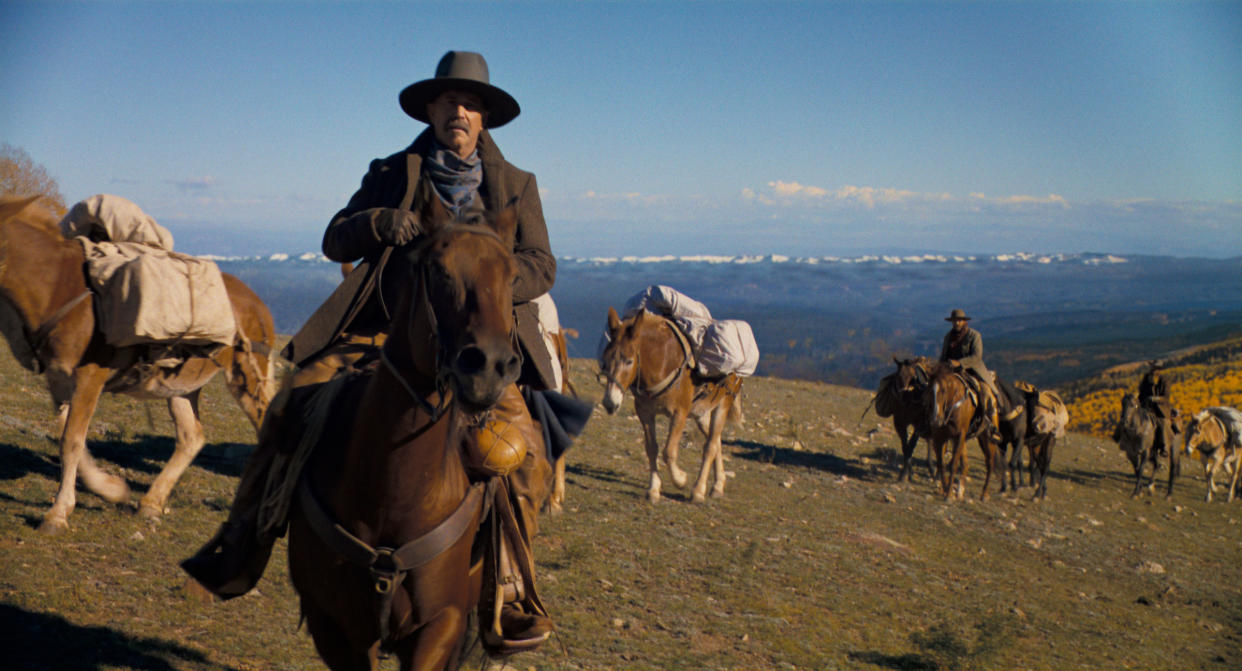Kevin Costner Western Horizon and the Real Civil War History

Giddy up: Horizon: An American Saga, out in theaters on June 28, is a new Western set in the Civil War-era by Kevin Costner, who directed, co-wrote, produced, and starred in the movie. Horizon: An American Saga is the first of four films in this project; the second part hits theaters on August 16.
Hollywood has a long history of romanticizing the Western United States, especially in pushing the myth that much of it was empty wilderness in the mid-19th century. In fact, it was very much the opposite: The region was populated by Native Americans, Asian immigrants and descendants of Spanish settlers trying to protect their own livelihoods. Costner says in the press notes that he didn’t want to make another movie that looked back on the era as a simpler time. He wanted to show how complicated it was, and draw out how all of these groups were butting heads. Horizon is a very violent film.
Costner's best-known western is 1990's Dances with Wolves, which became the second film about Native Americans to win Best Picture (after Cimarron in 1931). As TIME wrote in a review, the goal of the film is "make us ponder the cost of fencing off our former spaciousness and degrading the peoples who lived within it."
For some background on what was really going on in the Western U.S. during the early years of the Civil War era, TIME talked to Civil War historian Megan Kate Nelson, author of The Three-Cornered War: The Union, the Confederacy, and Native Peoples in the Fight for the West.
Who’s who in Horizon
Over three hours, the movie follows several different characters en route to a settlement called Horizon, lured by a flier that promised land for anyone brave enough to make the journey.
After her husband is killed on their journey west, Frances Kittredge (played by Sienna Miller) and her daughter Elizabeth Kittredge (Georgia MacPhail) are taken in by the Army at Fort Gallant. The two women become beloved members of the community, reminding the soldiers of the daughters and wives that they left back home.
Costner plays Hayes Ellison, a loner who is drawn to Horizon because he wants to start a new life. He is joined by a woman named Marigold (Abbey Lee), who worked as a prostitute in a mining town called Watts Parrish, which is supposed to be in present-day Wyoming
There is a British couple, Hugh Proctor (Tom Payne) and Juliette Chesney (Ella Hunt), who are inspired by the ideals of starting anew, but utterly lack survival skills and annoy their fellow wagon travelers with their inability to even fetch their own water.
The movie had several consultants on Native American culture, and Native American actors who learned the White Mountain Apache dialect for the roles. For example, actor Tatanka Means plays Taklishim, an Apache who lives in the mountains of present-day Arizona and is trying to protect his family as the settlers encroach.
The Civil War in the context of Horizon
The four-part Horizon series is set during the Civil War (1861 to 1865), with part one starting in 1859, just before the war began. The war went beyond battles between the North and the South, and played out in the Western territories as well.
“All of the fights over slavery between northern and southern politicians are about expansion of slavery into territories,” says Nelson. “The Confederacy was very interested in taking control of the West because they wanted gold mines. They wanted Pacific ports. And the Confederacy wanted a coast-to-coast-nation so that they would be more legitimate and more recognized.”
Settlers going West wanted a new life and were primarily looking for gold, Nelson said. There was the California Gold Rush in the 1840s, a big gold rush in Colorado in the late 1850s, and another gold rush in Montana in 1863.
Chinese laborers are depicted in Horizon. According to Nelson, they originally came to California for the gold rush, and then migrated to mining towns in Montana and Utah. In the movie, they are lowly workers who get yelled at for not speaking English. In reality, they started their own businesses like laundries, restaurants, saloons.
But Western settlers became directly involved in the war. In fact, there was a civil war within the Civil War in New Mexico in the 1860s. The Union recruited Native Americans as spies and formed an army with a mix of Hispanic and white men in Colorado, who ended up out West because they had been searching for gold. In the 1860s, white settlers took on the Native American warfare practice of scalping—killing their enemies and then ripping off their scalps.
The only area the Confederacy managed to win in this period was present-day Arizona. But in the end, the Union won the Civil War, and its appointees were put in place in the settlements out West to ensure slavery was not incorporated into these territories.
However, Nelson points out Native Americans were never fully allied with the Union army, seeing them as trespassers. For example, once the U.S. government started building the transcontinental railroad (1863-1869), Native Americans attacked railroad surveyors. Apaches would charge a toll to gold miners on routes between Texas and California, forcing them to fork over their food, weapons, and horses.
In Horizon, most of the time spent with Native Americans characters depict them attacking white settlers. Costner said he wanted to depict the Native Americans as literally fighting for their lives and their dignity. But in press notes, he also concedes, “I don't pretend to be the best person to do that exactly.”
As for his approach to this four-part epic in general, he said, "I think, in a way, that I'm somebody that just had to go west myself, and not know what was out there, and not be afraid of it."
Write to Olivia B. Waxman at olivia.waxman@time.com.


